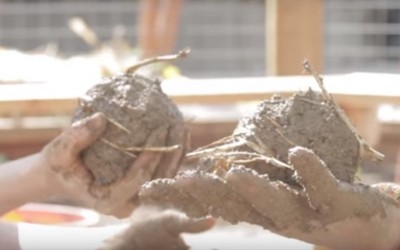Survival cement has been used for thousands of years, and it’s still in use on a daily basis in some undeveloped parts of the world.
But let’s begin with the basics: What is “survival cement”? The simple answer is a mixture of mud and grasses. Also known as cob and clom (in Wales), this is the stuff dream homes used to be made of, back in the day.
People used survival cement for a variety of projects, ranging from building shelters to ovens, food caches and kilns. The only limit in cob’s uses is one’s imagination, and during a survival situation, knowing how to make it could help you stay alive.
The general idea is that if built nice and proper, a cob-made house easily will outlive you.
What you will need for making cement is very basic: mud, water and dry grass/straw. The process of making cob is very simple, requiring a minimal set of skills and labor. A tarp is beneficial.
New Water Filter Fits In Your Pocket And Removes 100 Percent Of Water-Borne Bacteria!
To make high-quality survival cement, you should take care of a few things first. If you’re going to use the cob as a mortar, then make sure that the mixture is wetter and thinner so it will easily fill the joints/crevasses between bricks.
Depending on the type of structure you’re building, you should cut the grass to match the length of the item you want to manufacture, i.e. for large structures like kilns, you can let the grass grow as long as you want, and it will act like a type of reinforcing bar. The idea is that if you require tougher survival cement, then place the grasses parallel to each other, thus creating a heavy-duty building material. If you want to make a mixture for bricks, then you can use shorter grass.
Don’t let the mixture dry out if you run out of grass and you have to make an additional “gathering” trip. Cover it as best as you can.
Finally, if you have to add water to your mixture, add a little bit at a time, because it’s a hard job to rejuvenate a soupy/unusable mud mixture.
The First Step to Making Survival Cement
The most important ingredient in making cob is the mud, which should be as good as it gets. High quality mud for survival cement contains lots of clay. It’s easy to determine if you have enough clay: If you make a ball from the respective mud and it retains its shape, you’ve got the right stuff.
New Survival Energy Product Makes Every Window A Powerful Solar Charger
Next, you must go hunt for dry grasses or straw, in a sufficient amount for your project, and cut them into various lengths.
Provided you have access to a water source, it’s time to add some water into the mix. Hydrate your clay to the optimal density for making bricks. That means you must be able to squish the clay through your fingers, yet it should maintain its shape when you mold it. Take care not to make your clay too watery or too dry. Find the right balance depending on your project. For bricks or other similar structures, you may use a firmer mixture; for mortar, you must use a thinner one.
Now, it’s time to mix the grasses/straw with the clay, and the easiest way to achieve that is to put them together and mix them on a tarp on the ground. Take a look at this video, which also uses sand:
Making cob and building stuff outdoors can be very entertaining — and you can even co-opt your kids. Mixing playful activities while learning vital survival skills is a winner in my book.
Start with making some test-bricks, since the “correct” recipe for cob is very flexible; see what suits you best, because there are lots of variations which all work pretty well. The only thing to remember is not to add too much straw, or your survival cement will fall apart. The more clay in the mix, the more straw you may add, but you must test it yourself and see how it feels.
You do realize that bricks are the building blocks for the pyramids, right? The sky and your imagination are the limit.
What advice would you add? Share it in the section below:
Learn How To ‘Live Off The Land’ With Just Your Gun. Read More Here.
 Off The Grid News Better Ideas For Off The Grid Living
Off The Grid News Better Ideas For Off The Grid Living




